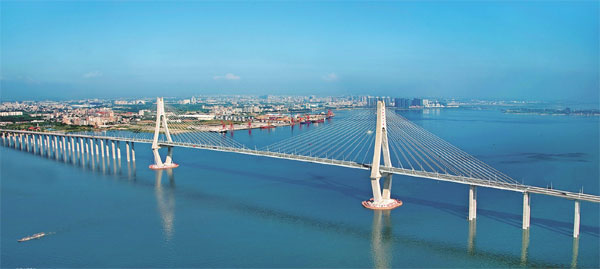Focus on foreign trade
Coastal city strengthens international ties, attracts investment
Zhanjiang achieved breakthroughs in international exchanges and cooperation with the establishment of economic and trade representative offices in Germany, Sri Lanka and Cambodia last year.
The German office is in the German Chamber of Industry and Commerce Greater China office, in Karlsruhe.
|
Zhanjiang port handled more than 200 million tons of cargo last year, making it one of the leading ports in Guangdong province. Photos provided to China Daily |
The German chamber has extensive links to German businesses, especially small and medium-sized enterprises. It serves more than 3.6 million companies at home and more than 3,000 of the 5,000-plus German companies with a presence in China.
The trade office offers a "window through which we will be able to see what German businesses need, what they want to know and what they are interested in for better cooperation", said Zhanjiang's mayor, Wang Zhongbing, at the office's opening ceremony in June.
The Zhanjiang government hopes to attract more German companies including SMEs, he said.
The trade office in Sri Lanka was established at Colombo International Container Terminals Ltd, which is a joint venture between Hong Kong-listed blue chip China Merchants Holdings International Co and the Sri Lanka Ports Authority.
Liu Xiaohua, Party chief of Zhanjiang, encouraged the office to promote Zhanjiang's business environment and facilitate two-way investment and trade at the launch ceremony in December.
The Cambodian office was set up at the Rui Feng Cambodia International Co invested by Zhanjiang-based Guangdong Hengfu Group Sugar Industry Co.
Liu said he hoped overseas companies invested by Zhanjiang firms would better connect to the industries in Zhanjiang and make greater contribution to the city's economic and social development.
Zhanjiang registered a 15 percent growth in foreign trade, which stood at $6.3 billion last year.
Contractual foreign investment surged 384 percent to $392 million and actual foreign investment rose by 14 percent to $150 million in the year.
To step up support for foreign trade, the city's bureau of commerce provided tailor-made services to companies in the sector, said Wang Xiaosui, director of the bureau.
For instance, the bureau's officials were assigned to support certain companies, she said.
Aquatic products show
The first session of the China International Aquatic Products Exposition held in the city in June helped establish a high-end trading platform for the aquatic industry, which contributed to a substantial share of the city's foreign trade.
Zhanjiang's foreign trade with Southeast Asian nations exceeded 5.3 billion yuan ($848 million) last year and included more than 3.9 billion yuan in exports, according to Zhanjiang Customs. Southeast Asia has become the largest destination for exports from the city.
The administration of Fenyong Economic Zone in Zhanjiang signed a cooperative agreement with Indonesia's Mudia Dean Sentosa Co in June last year to build Sino-Indonesian Zhanjiang Industrial Park in Zhanjiang and the Indonesia-China Pacific Rubber Sci-Tech Industrial Park in Indonesia.
The administration of Fenyong said it was seizing opportunities arising from the national strategy to build a 21st Century Maritime Silk Road and taking advantage of its geographical location and connections with overseas Chinese.
It aims to build the zone into a major platform for cooperation with countries along the road.
The city will support a sisal hemp production project in Indonesia and a sugar cane production project in Sri Lanka invested by Guangdong Zhanjiang Agribusiness Group Co, according to the government's work report delivered in January.
It will work to expand cross-border e-commerce, strengthen exports to markets in Europe and the United States and explore emerging markets to foster new foreign trade growth areas.
Zhanjiang was the nation's top aquatic product exporter last year, with 122,800 tons of products worth $988 million. Prawn exports from the city made up about 30 percent of the national total.
liwenfang@chinadaily.com.cn

























